



Hypoglycemic agent. It is an incretin mimetic and is a 39-amino-amidopeptide. Incretins, such as glucagon-like peptide-1 (GLP-1), increase glucose-dependent insulin secretion, improve β-cell function, suppress inadequately increased glucagon secretion, and slow down gastric emptying after they enter the bloodstream from the intestine. Exenatide is a potent incretin mimetic, which causes an increase in glucose-dependent insulin secretion and has other hypoglycemic effects inherent to incretin, which allows for improved glycemic control in patients with type 2 diabetes.
The amino acid sequence of exenatide partially corresponds to the sequence of human GLP-1, as a result of which it binds and activates GLP-1 receptors in humans, which leads to increased glucose-dependent synthesis and insulin secretion from β-cells of the pancreas with the participation of cyclic AMP and / or other intracellular signal ways. Exenatide stimulates insulin release from β-cells in the presence of elevated glucose concentrations.
In terms of chemical structure and pharmacological action, exenatide differs from insulin, sulfonylurea derivatives, D-phenylalanine derivatives and meglitinides, biguanides, thiazolidinediones and alpha-glucosidase inhibitors.
Exenatide improves glycemic control in patients with type 2 diabetes due to the following mechanisms.
In hyperglycemic states, exenatide enhances glucose-dependent insulin secretion from β-cells of the pancreas. This insulin secretion stops as the concentration of glucose in the blood decreases and approaches its normality, thereby reducing the potential risk of hypoglycemia.
The use of exenatide restores or significantly enhances both the first and second phase of the insulin response in patients with type 2 diabetes.
In patients with type 2 diabetes with hyperglycemia, administration of exenatide suppresses excessive secretion of glucagon. However, exenatide does not interfere with the normal glucagon response to hypoglycemia.
It has been shown that the administration of exenatide leads to a decrease in appetite and a decrease in food intake; inhibits gastric motility, which leads to slower emptying.
In patients with type 2 diabetes, therapy with exenatide in combination with metformin, thiazolidinedione, and / or sulfonylurea drugs leads to a decrease in fasting blood glucose, postprandial blood glucose, and HbA1c, thereby improving glycemic control in these patients.
Type 2 diabetes mellitus as monotherapy in addition to diet and exercise to achieve adequate glycemic control.
Type 2 diabetes mellitus - as an additional therapy to metformin, a sulfonylurea derivative, thiazolidinedione, a combination of metformin and a sulfonylurea derivative, or metformin and thiazoldinedione in the absence of adequate glycemic control.
1 pack - exenatide 2 mg
Exenatide is marketed under different brands and generic names, and comes in different dosage forms:
| Brand name | Manufacturer | Country | Dosage form |
|---|---|---|---|
| Byetta® | AstraZeneca | UK | cartridge |
| Byetta® | AstraZeneca | UK | pen |
No customer reviews for the moment.
SubQ in the thigh, abdomen or forearm.
The initial dose of Bayeta Long is 5 mcg, which is administered 2 times / day at any time during the 60-minute period before the morning and evening meals. Do not enter after meals. 1 month after the start of drug treatment, the dose can be increased to 10 μg 2 times / day.
On the part of the digestive system: with monotherapy - nausea, vomiting, diarrhea, dyspepsia, loss of appetite; in combination therapy, nausea, vomiting, diarrhea, loss of appetite, dyspepsia, gastroesophageal reflux, abdominal pain, bloating, belching, constipation, disturbed taste, flatulence, acute pancreatitis. Perhaps - belching, constipation, flatulence; rarely acute pancreatitis.
From the side of the central nervous system: with monotherapy - dizziness; with combination therapy - dizziness, headache, drowsiness. Perhaps - dysgeusia, drowsiness.
On the part of the endocrine system: hypoglycemia is possible; in combination therapy, hypoglycemia (in combination with a sulfonylurea derivative).
On the part of the metabolism: in combination therapy - hyperhidrosis, dehydration (associated with nausea, vomiting and / or diarrhea).
From the urinary system: in combination therapy - renal dysfunction, including acute renal failure, aggravation of chronic renal failure, increased serum creatinine content.
Allergic reactions: with combination therapy - angioedema, anaphylactic reaction.
Dermatological reactions: possible - maculopapular rash, pruritus, urticaria, angioedema, alopecia.
Local reactions: itching at the injection site, rash, redness at the injection site.
Others: in combination therapy, trembling, weakness. Perhaps - increase in INR (with combination with warfarin), in some cases accompanied by the development of bleeding).
Hypersensitivity to the drug, type 1 diabetes mellitus, the presence of diabetic ketoacidosis; severe renal failure (QC; lactation period (breastfeeding); age up to 18 years.
With simultaneous use of digoxin (0.25 mg 1 time / day) with exenatide, Cmax of digoxin decreases by 17%, and Tmax increases by 2.5 hours. However, the AUC in an equilibrium state does not change.
On the background of administration of exenatide, AUC and Cmax of lovastatin decreased by approximately 40% and 28%, respectively, and Tm increased by approximately 4 hours.
In patients with mild or moderate arterial hypertension, stabilizing while receiving lisinopril (5-20 mg / day), exenatide did not change the AUC and Cmax of lisinopril in equilibrium. Thin lisinopril in equilibrium increased by 2 hours. There were no changes in the average daily systolic and diastolic blood pressure.
It was noted that with the introduction of warfarin 30 minutes after exenatide, Tmax increased by approximately 2 hours. There was no clinically significant change in Cmax and AUC.
Contraindicated use during pregnancy and lactation (breastfeeding).
Do not enter exenatide after a meal. Do not enter IV or IM.
Due to the potential immunogenicity of drugs containing proteins and peptides, during the treatment with exenatide, the production of antibodies to the active substance is possible. In the majority of patients in whom the production of such antibodies was noted, their titer decreased with the continuation of therapy and remained low for 82 weeks. The presence of antibodies does not affect the frequency and types of reported side effects.
Exenatide can cause delayed gastric emptying. Therefore, simultaneous use with drugs that require rapid absorption from the gastrointestinal tract for the development of the action is not recommended.